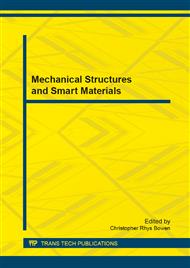[1]
SA. Alexander, Effects of orthodontic attachments on the gingival health of permanent second molars, Am J Orthod Dentofacial Orthop. 100 (1991) 337–40.
DOI: 10.1016/0889-5406(91)70071-4
Google Scholar
[2]
S.J. Ahn, B.S. Lim, H.C. Yang, Y.I. Chang, Quantitive analysis of the adhesion of cariogenic streptococci to orthodontic metal brackets, Angle Orthod. 75 (2005) 666-71.
Google Scholar
[3]
L. Gorelick, A.M. Geiger, A.J. Gwinnett, Incidence of white spot formation after bonding and Banding, Am J Orthod. 81 (1982) 93–98.
DOI: 10.1016/0002-9416(82)90032-x
Google Scholar
[4]
B. Ogaard, Prevelence of white spot lesions in 19 years olds: a study on untreated and orthodontically treated persons 5 years after treatment, Am J Orthod Dentofacial Orthop. 96 (1989) v423-27.
DOI: 10.1016/0889-5406(89)90327-2
Google Scholar
[5]
E. Tufekcia, J.S. Dixonb, J.C. Gunsolleyc, S.J. Lindauerd, Prevalence of white spot lesions during orthodontic treatment with fixed appliances, Angle Orthod. 81 (2011) 206–10.
DOI: 10.2319/051710-262.1
Google Scholar
[6]
H.S. Chang, L.J. Walsh, T.J. Freer TJ, Enamel demineralization during orthodontic treatment. Aetiology and prevention, Aust Dent J. 42(5) (1997) 322-27.
DOI: 10.1111/j.1834-7819.1997.tb00138.x
Google Scholar
[7]
C.M. Forsberg, V. Brattström, E. Malmberg, E.C. Nord, Ligature wires and elastomeric rings: two methods of ligation, and their association with microbial colonization of Streptococcus mutans and Lactobacilli, Eur J Orthod. 13(5) (1991) 416-20.
DOI: 10.1093/ejo/13.5.416
Google Scholar
[8]
G.H. Gameiro, D.F. Nouer, M.S. Cenci, J.A. Cury, Enamel demineralization with two forms of archwire ligation investigated using an in situ caries model — a pilot study, Eur J Orthod. 31 ( 2009) 542–46.
DOI: 10.1093/ejo/cjn119
Google Scholar
[9]
G. Başaran, O. Hamamc, Evaluation of the effect of different ligature system on microbial Attack, Balk J Stom. 11 (2007) 201-03.
Google Scholar
[10]
K.K. Miura, I.Y. Ito, C. Enoki, A.M. Elias, M.A.N. Matsumoto, Anticariogenic effect of fluoride-releasing elastomers in orthodontic patients, Braz Oral Res. 21(3) (2007) 228-33.
DOI: 10.1590/s1806-83242007000300007
Google Scholar
[11]
A.F.F. Magno, C. Enoki, I.Y. Ito, M.A.N. Matsumoto, G. Faria, P. Nelson-Filhof, In-vivo evaluation of the contamination of Super slick elastomeric rings by Streptococcus mutans in orthodontic patients, Am J Orthod Dentofacial Orthop. 133(4) (2008).
DOI: 10.1016/j.ajodo.2006.04.054
Google Scholar
[12]
S.J. Ahn, H.S. Kho, S.W. Lee, D.S. Nahm, Roles of salivary proteins in the adherence of oral Streptococci to various orthodontic brackets, J Dent Res. 81 (2002) 411-15.
DOI: 10.1177/154405910208100611
Google Scholar


